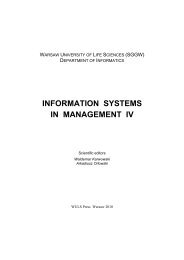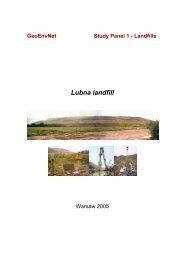ACTA SCIENTIARUM POLONORUM - SGGW
ACTA SCIENTIARUM POLONORUM - SGGW
ACTA SCIENTIARUM POLONORUM - SGGW
You also want an ePaper? Increase the reach of your titles
YUMPU automatically turns print PDFs into web optimized ePapers that Google loves.
160 M. ŻakWhile discussing changes that occurred in the rural women’s movement, it is necessaryto present the most important factors determining their activity. Firstly, the distinctionwithin the rural women’s movement itself should be made. It is a social movementwhich, at the same time, is one of the tendencies in women’s movement in general[Ślęczka 1999, Fuszara 2007]. The rural women’s activity is a social activity or, in otherwords, a civic activity. It can be defined as a sphere of public life reflected in various organizationaland legal forms. People acting in this sphere achieve various goals throughorganizational forms suggested by them [Szustek 2009].RURAL WOMEN’S SOCIAL AND PROFESSIONAL SITUATIONIn spite of the fact that social family patterns have changed over the last two decadesand although the relations between spouses are more and more often based on partnershipand the education of women lasts longer, it is difficult for them to be a full-time employeeoutside the farm. Moreover, women take care of their children and other dependents (e.g.of the elder and disabled family members) [Sawicka 2005]. According to J. Sawicka, thewomen’s position is still influenced by the following factors: education, profession andincome. At the same time she pays attention to the fact that “most rural women do notmatch the traditional image of a rural woman because they make a considerable contributionto the family business” [Sawicka 2005].On the other hand, there still exists a division of activities that remain a women’sdomain and those reserved for men. There are two categories of decisions made in ruralfamilies: the first ones concern the agricultural production while the other apply to organizationof family life and running a household. This distinction suggests that the tasksare divided into male and female ones. For instance, women usually do not interfere inplanning the field works since they consider them to be men’s domain. It means theywithdraw from this area. However they would like to influence the decisions concerningthe household budget more often and therefore credit and commercial agreements are negotiatedand entered into by both spouses [Kurek 2006]. Thanks to these gradual changes,the relations in rural families are more often based on partnership. The additional factorsupporting the transformation of these relations is taking up a job by women outside thehousehold. By doing so their earnings contribute to family income [Kurek 2006].The approach to the need for rural women’s education is also changing. Education isperceived as a chance of development and self-realization. The rural women’s educationallevel is increasing particularly among young women. Nevertheless, rural women are stillworse educated in comparison with inhabitants of towns. In 2005 only 3.7% out of allfemale members of families running a farm who attained the age of 13, received highereducation. In the same group 46.2% of women received secondary or post-secondary education.The educational level of the inhabitants of Polish villages considerably increased incomparison with the results of the Agricultural Census conducted in 1996 [Kurek 2006].As a rule, rural women undertake lower-risk actions which do not require professionalknowledge, e.g. they run farm tourism businesses. In order to encourage women to bemore active, various attempts are made not only through the actions of state officials andnon-governmental organizations providing the information on development possibilities,but also through mass media and TV series in particular [Michalska-Żyła 2008].Acta Sci. Pol.
















